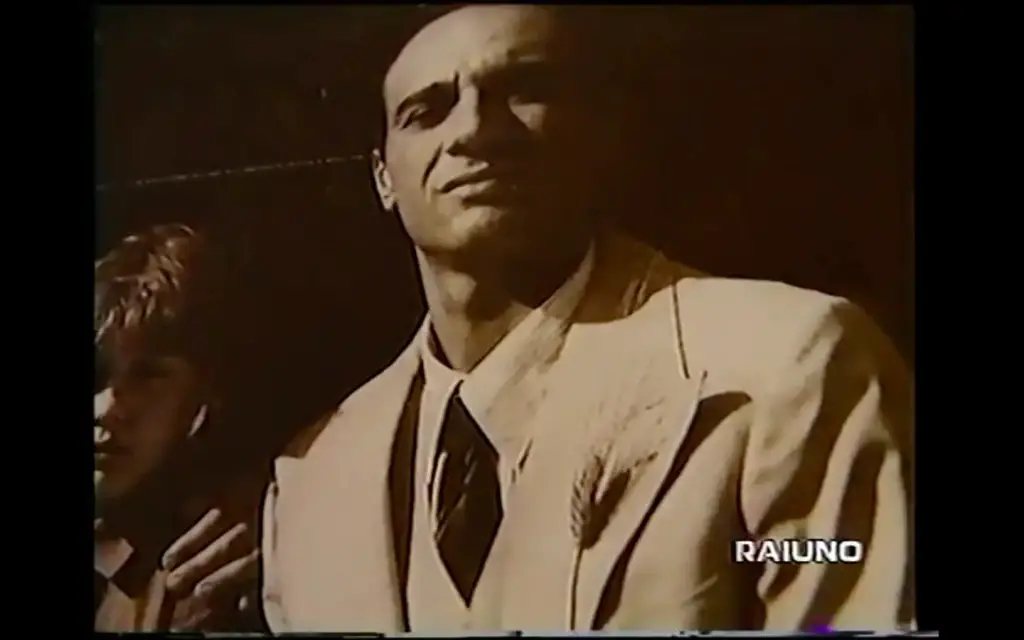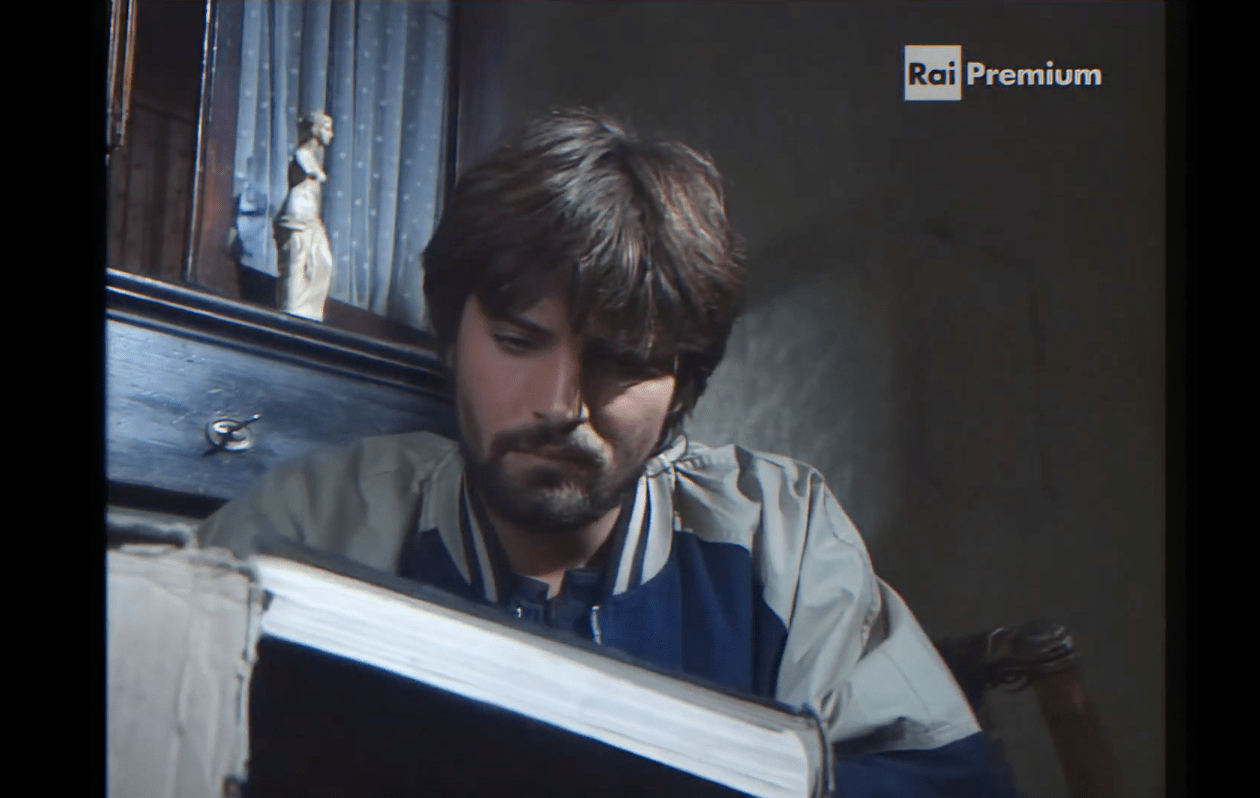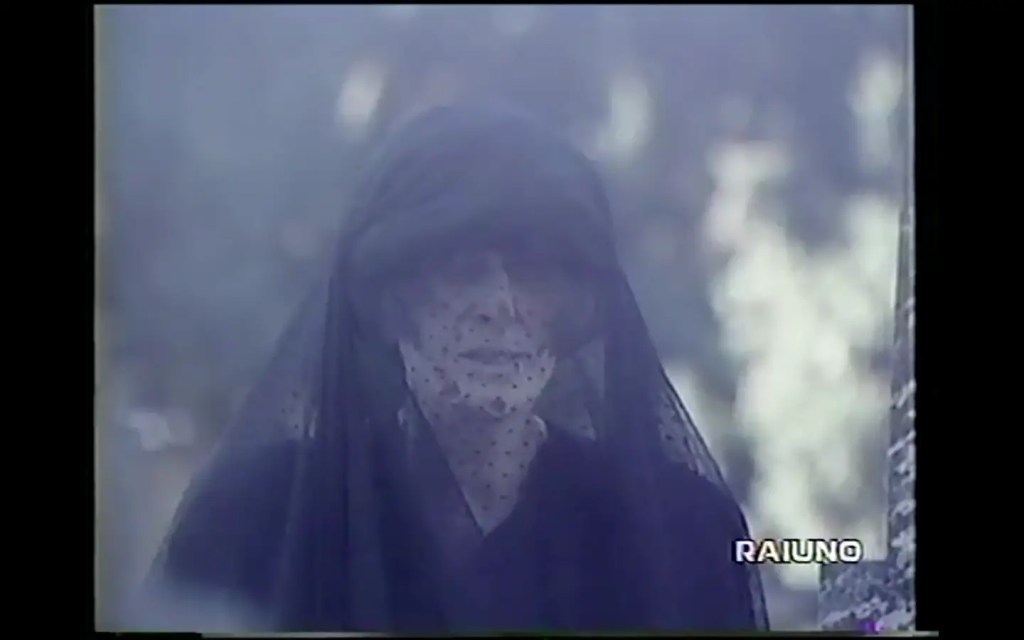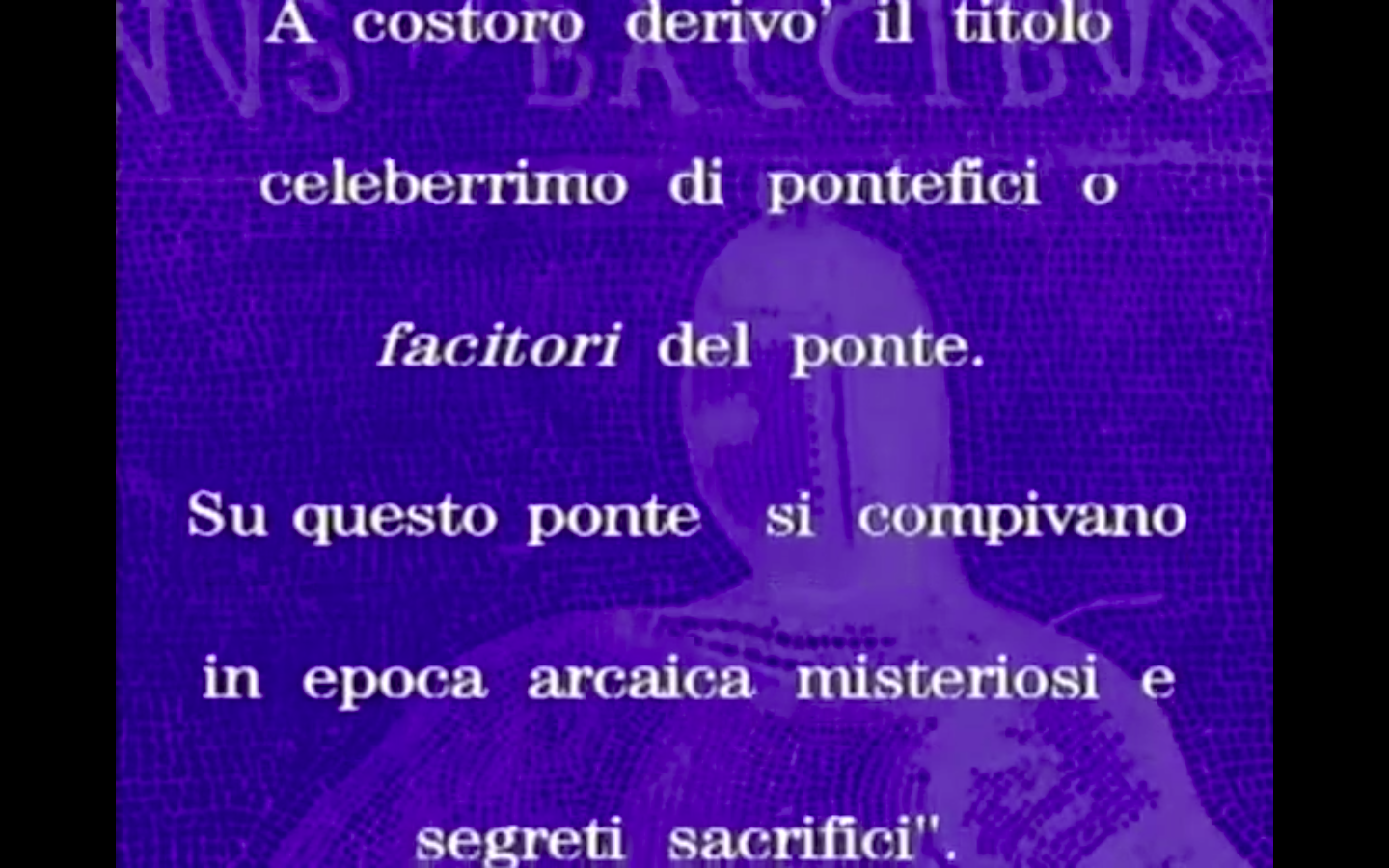Broadcast for the first time on September 24, 1995, the television drama written by Pupi Avati and directed by Fabrizio Laurenti is now twenty-six years old. Let's go over, for the occasion, the esoteric and occult elements that emerge from the vision of the five episodes that compose it.
di Marco Maculotti
“BLACKED: planet that causes death. In the conditions of the highest magnitude, the phenomenon that the ancients called the double occurs and that we know to be the egregore, the materialization of the energy of thought that produces phenomena of ubiquity. It draws life from sacrifice, linked to it, with conjurations, mysteries, divine names and sacred signs. The anointed and blessed victim will be led before the sacrifice into a triangle placed outside the place, where the builders of the passage will be waiting for him. The day and astral hour suitable for the passage will be established by the calculation of the hour of birth in the triangulation with the 24th of Artemis (24th August), the 5th of Ares (5th October) and the 8th of Priam (8th November). "
Voices of the night, ep. V (1995)
Someone [1] pointed out that the television fate of Voices of the night, a RAI script that aired starting from 24 September 1995, conceived and written by Pupi Avati e directed by Fabrizio Laurenti, was not very dissimilar to that of Twin Peaks, the famous TV series of the Lynch / Frost duo that only a few years earlier, on Canale5, saw its ratings diminish from episode to episode, as soon as the name of the protagonist's murderer was revealed [2]. On the other hand, with regard to the scarce predisposition to the mystery of the average Italian (and of the average Italian family) in recent decades, it has already been understood for some time how the public, following the binge of more or less "esoteric" products over the years '60 and '70 (ex multis, The sign of command, 1971), seems to have irremediably lost the taste of mysterious and mysterious, as if at some point it has reached the threshold of saturation. The somewhat muted release of the third "occult" film by Avati himself, thatArcane charmer (1996) which, despite being completely up to the previous films of the director ascribable to the trend of the so-called "Gothic Padano", will not be able to repeat the success of the public or de La house with laughing windows (1976) nor by Zeder (1983)
If this were not enough, let's say right away that conceptually Voices of the night was an even braver experiment than previous films, although the background of esoteric beliefs (one above all, that on the survival of the soul at physical death and on the Hereafter in which it would continue to dwell; a leitmotiv present in all three of the titles mentioned above) is roughly the same. As had previously happened with the necropolis and the "K land" of Zeder - and similarly to movies from the 70s and 80s like The Etruscan kills again (Armando Crispino, 1972), The bloody locket (Massimo Dallamano, 1975) and Murder in the Etruscan cemetery (Sergio Martino, 1982) - the Emilian director continues to take inspiration from the ancient and sinister legends connected to the still little known chthonic cults of the Etruscans [3] in pre-Roman times. In this we can see a typical narrative device of the vein folk horror British, where obviously the suggestions used have to do with the Celtic tradition [4].
At the center of the mysterious story there is in fact the memory (that solo memory is not) Of ancestral sacrificial rites with human victims, officiated by the priests of the cult from Sublicio bridge, which was the first sacred bridge for the Romans, evidently continuers of a more archaic tradition, of Etruscan ecumene. The bridge from which the sacrifice was made had been built, centuries before the Roman rule, in wood without the use of nails (Sublicius it really means "resting on poles"): a peculiarity to be connected perhaps to the belief widespread in ancient times, eg. also in Celtic countries, on the negative effect of iron on spirits residing in the Other World.
It was therefore a very ancient rite, an outward expression of a partly aquatic cult officiated in Roman times by priestly college of the Argei: every year the vestals threw some from the bridge wicker mannequins, as a reminiscence of the never forgotten (and, perhaps, never really interrupted) human sacrifices which were made in the same place in pre-Roman times. The victim was previously sprinkled with ointments and made to swallow a purifying substance, a silphium extract, to separate it from the profane world. The aforementioned background history of the events narrated in the five episodes that make up Voices of the night it is reported to us in the middle of a dialogue in episode IV: a testimony by Marco Terenzio is also reported Varro, according to which the designated victims (two at a time) were drowned in the Tiber, formerly called Albula.
Since the times of the Etruscan domination - it is revealed later - i bridge builders (pontifex) they had kept the strictest secrecy on the initiatory secret connected to ritual sacrifices, of which they were and - suggest the events narrated in Voices of the night - they are still the only custodians. From this semi-secret brotherhood, as is explained in the fourth episode, that of the Brothers Masons and Builders of Cathedrals Gothic. It is also said that the members of the sect, who among themselves are called alternately "keepers of the passage", "builders of the passage" and "builders of the bridge", they remember their past lives and believe themselves to be immortal, as well as being capable of killing in order to jealously keep one's secrets.
One of these lies precisely in the use of the sylph: own silphium seeds are found in the stomach of Giacomo Fiorenza, the dead boy suddenly at the opening of the pilot episode of the serial ... just a pity that the silphium plant has been extinct for at least 1500 years! In any case, later (ep. IV) it is revealed that using him causes astonishing effects: in fact, weak electrical signals continue to be recorded in the brain mass of the young Giacomo, even months after his death.

From the second episode it is understood that Giacomo had come into contact, through Emily Sabina Cohen - an ambiguous American girl, albeit of Jewish origin like him, whom the young man was recently dating - with a mysterious sect called "Theosophical Society for the Return of the Original Spirit", which is said to have several "men within many centers of power" [5]. It is precisely from the Saint Louis headquarters of the Society, Missouri, that the sinister phone calls start with the voice of the young man whose body has already been found, as if it came directly from theAfterlife. The mystery deepens when the investigators realize that, by calling the number from which the desperate requests for help come, an answering machine always answers, which articulates the following warning in clear syllables:
"Look no more here for the creator of energy: the men of the earth have hunted him for ever."
(ep III)
The elusive figure of a scholar named Norberto Sinisgalli, dedicated in the '30s and' 40s to esoteric and occult studies, which also interested his rich and fascinating companion Maria Valover, whose niece Elena is now elderly and unable to sleep in the "Pensione Rosetta" that hosted Giacomo. Although Sinisgalli was also from Jewish origin, nevertheless it is rumored that he collaborated with the Germans and profited from the deportation of his corracials during the final years of the Second World War, and that "after the Allies arrived, Sinisgalli disappeared ... as if he had been sucked into nothingness". Elena says about him that “He knew many things without having studied them, and he said it was enough remembering what you were before… in previous lives" (ep. III). It is also rumored that he always wore one at the buttonhole of his jacket gold brooch in the shape of an ear of corn: symbolism connected to the metaphysics of the seed and the ear on which they were centered, in ancient Greece, i Eleusinian Mysteries.

On the singularity of the character of Norberto Sinisgalli and on the possible inspiration, for the purposes of the genesis of his figure, to any historical characters that really existed, various critics have advanced heterogeneous hypotheses, most of which however seem literally far-fetched. Perhaps the most convincing of all is in the opinion of the writer the one advanced by Andrea Scarabelli [6], who honors me with his friendship, during a friendly conversation: in his opinion, Sinisgalli may have been "drawn" on the figure of the traditionalist philosopher Julius Evola (which Pupi Avati certainly knows and in all probability already knew at the time of Voices of the night), a character in a certain sense "Luciferian" and "Promethean" who, as is well known, throughout his life was interested in esoteric doctrines (and not only in theory, but also in practice).
Two other clues that could corroborate Scarabelli's hypothesis are the alleged (and self-styled [7]) "Collaborationism" of Evola with the Germans and a kind of play on words contained in the surname of his collaborator Maria VALOVEr: if we omit the first and last letter and read it backwards, in fact, the amazing result will be precisely ... the surname of the traditionalist thinker! (Could it perhaps be assumed that the remaining letters "VR" are an allusion to "UR", the journal of esoteric studies in which Evola collaborated in the late 20s?) In addition, if this were not enough, one might think also a reference to the Russian poetess and occultist Maria de Naglowska, practitioner note of magic sexualis that of Evola he was, for a certain period of his life, a "magical lover". In this sense, Maria Valover it could also be interpreted as a contraction of ... Maria (E) V (ol) a-lover.
Although Evola was by no means of Jewish origin, it is not indifferent that she is in the television serial Sinisgalli, as is Giacomo Fiorenza and his family, Emily Sabina Cohen and, in all probability, a large number of members of the Society in the its entirety. This could perhaps be connected, among other things, to the custom of circumcision: in the second episode a passage of the stromata by Clemente Alessandrino in which this practice is referred to as a required action “to have access to the Pythagorean Mysteries". And in the fifth episode we explicitly speak of circumcision as a "sacrifice to the lunar and fertility deities, as a protection of the regenerative forces", Or alternatively a"corollary to sacrifice and purification"; and the authoritative opinion of Sir James Frazer, according to which it was believed in ancient times that such a practice would ensure a future rebirth, which is why it was practiced by numerous primitive peoples.

So we finally come to Real "esoteric core" of Voices of the night. Taking into account the pieces that we have already joined, let's go with our minds to the apartment where the now elderly Elena Valover drags the last years of her existence, apartment inside the fictitious "Pensione Rosetta" that Maria once had her he shared with comrade Norberto Sinisgalli. Among the various rooms there is one permanently locked, full of funeral wreaths need bunches of flowers [8], as well as accumulated newspapers, on which Obituaries which have been circled dates of birth and death (or, as we shall see, of passage). The elderly tenant cryptically states that between the two dates there is a mysterious relationship (“A secret game” with which Maria “called the days and months with mysterious names”) and which “had started when Norberto was still there”. Although Sinisgalli is literally disappeared into thin air at the end of the war, Elena Valover swears that he still helps her "to make those strange calculations" (ep. IV).
It turns out, therefore, that the members of the "Theosophical Society for the Return of the Original Spirit", continuing the ancient Etruscan and Roman tradition, are able to perfectly calculate what Elena Valover defines as the changeover day: or the date, obtained taking into account the respective birth chart of each adept, in which the person who dies can to be reborn in another form, evidently more "subtle" and intangible than the common existence. These days can be related, as is explicitly done in the fifth episode, with the Parentalia and lemuria, the days in which according to the Roman tradition the Mundus Patet (o Mundus Cereris) and therefore the living could enter into communication with the spirits of the dead residing in the Underworld. Once immolated on the correct dates - we are told - these people are no longer mere followers, but "they enter through knowledge into a larger world, in which death does not exist"(Ep. IV). In short, it is "get rid of the idea of time"(Ep. IV) and, as it is said in the final episode in the form of a reference to the Eleusinian Mysteries and to the pin in the shape of an ear of corn that Sinisgalli used to wear, of
"to die in the mortar and be reborn as a thorn of harvested wheat."
(ep. V)

However, the otherworldly testimony of the now deceased Maria Valover (arrived on the other side thanks to the rite of passage officiated by her niece Elena) in the final sequence shot in the cemetery suggests that - as in the previous "esoteric" films by Pupi Avati and similarly toBeyond di Fulci (1981) - the Other World accessed by sacrificed souls according to the protocols of the Society, far from presenting itself in the guise of locus amoenus and heavenly, it turns out to be on the contrary un dark place of eternal damnation, a silent limbo of eternal waiting conceptually close to that Twilight Zone sadly feared by Tiziano Sclavi in a well-known comic story [9] released in Italian newsstands a few years before the realization of Voices of the night:
“Some members of the sect” - commented Valover - “have crossed the forbidden threshold, entering paths in the dark that lead to Nothing. Only to the great fear of oneself and the fear of others ... "
"Where reason ends begins a territory that does not belong to us, in which we are intruders ... A land that has rules that we do not know, where a mysterious language is spoken and where our logics are not usable in any way ... We in this territory can only to undergo a mystery which, instead of unveiling itself, becomes more and more impenetrable ... I can't say whether this is a penalty or a reward, I don't know how to say anything ... but I know that this place where I am must not be sought in any way, nor in no way found ... "
(ep. V)

Note:
[1] Raffaele Meale, Voices of the night, on "quinlan.it", July 15, 2019.
[2] Among other things, the parallelism between the two serials is not entirely strange, starting from the curious fact that the pilot episode of both opens with the zoom on a young corpse wrapped in a plastic sheet, just rescued from a basin. water - there Laura Palmer who runs aground on the shore of the limotrophic lake in Twin Peaks, here Giacomo Fiorenza who runs aground like a wicker mannequin in a shoal of the Tiber.
[3] See, e.g., Giovanni Feo, The underground world of the Etruscans, ECIG, Genoa 2005.
[4] See Marco Maculotti, “The Wicker Man”: from folklore to folk-horror & “Penda's Fen”: the sacred daimon of ungovernability, on “AXISmundi.blog” and our first printed register AXIS MUNDI n.1 / year I, LAMMAS - Summer 2021. FOLK HORROR Special.
[5] A suggestion perhaps indebted to the stories of the cycle of King in Yellow by Robert W. Chambers, especially de The Reputation Repairer, and perhaps also of The Guests of the Hoodoo Room di Robert E. Howard.
[6] Among other things, contributor to our digital magazine [cf. Archive: articles divided by author: SCARABELLI, Andrea].
[7] The accusation was advanced several times by his detractors, and yet on the historical and practical level he never found an effective confirmation.
[8] Perhaps a reference to a famous scene from The short night of the glass dolls by Aldo Lado, 1971; but also, undoubtedly, a reference tosoul vegetative.
[9] "Dylan Dog" n.7, The Twilight Zone, Sergio Bonelli Editore, 1 April 1987.




cheers for the beautiful and very clear post
Thanks as always!